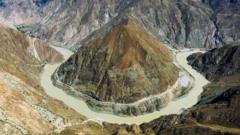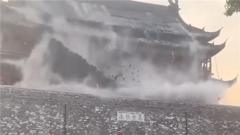The construction of the Gangtuo dam in Tibetan regions has ignited unprecedented protests that faced a ruthless crackdown by Chinese authorities. Witness accounts and verified media reports indicate multiple arrests and injuries among the local population, highlighting both the rapid infrastructure development priorities of the Chinese government and the enduring civil rights concerns surrounding Tibetan autonomy and cultural preservation.
Tibetan Protests Erupt Over Proposed Dam Project, Leading to Severe Crackdown

Tibetan Protests Erupt Over Proposed Dam Project, Leading to Severe Crackdown
A planned dam in Tibetan territories sparked rare protests in February, resulting in violence and arrests by Chinese authorities, raising ongoing concerns about the region's governance and the treatment of its inhabitants.
The Chinese government's plans to construct the Gangtuo dam on the Jinsha river have triggered rare protests among Tibetans that culminated in a severe crackdown in February, according to reports by the BBC. Once a region tightly controlled since China's annexation in the 1950s, such public dissent reflects heightened anxieties regarding cultural and environmental implications for local communities.
The protests arose as Tibetans learned about impending evictions linked to the dam's construction, which threatens to submerge crucial cultural and religious sites, including the centuries-old Wontoe Monastery. Although the Chinese embassy in the UK refrained from commenting on the specific protests, it stated that "China is a country governed by the rule of law” and emphasized the importance of lawful expression of concerns by citizens.
Eyewitness testimonies have revealed that hundreds of Tibetans demonstrated outside government offices in Dege, pleading for the cancellation of the dam project and calling for respect for their rights. However, this dissatisfaction was met with a swift police response, with many protesters reportedly beaten and detained. Leaked videos and satellite imagery have corroborated the existence of these protests.
Critics of the dam argue it represents a continuation of China's broader strategy to exploit Tibetan resources while undermining the local population's culture and rights. Activists contend that such infrastructure projects are often carried out with inadequate consultation, and without genuine consent from affected residents, contradicting the Chinese government's claims.
International bodies, including the UN, have raised concerns regarding the implications of the dam on local inhabitants and the environment, deeming the relocations as potentially irreversible and harmful. Despite China’s claims of compensating relocated communities, testimonies reveal feelings of displacement and distress among those who may be forced to abandon their ancestral homes.
As local conditions worsen, with increased surveillance and restrictions on communication, the protests, their brutal suppression, and subsequent repression reflect a critical juncture for Tibetan civil rights and highlight the struggle for cultural preservation amid infrastructure development. This situation, rooted in historical grievances, showcases the ongoing tension between development and human rights in Tibet's evolving narrative.


















